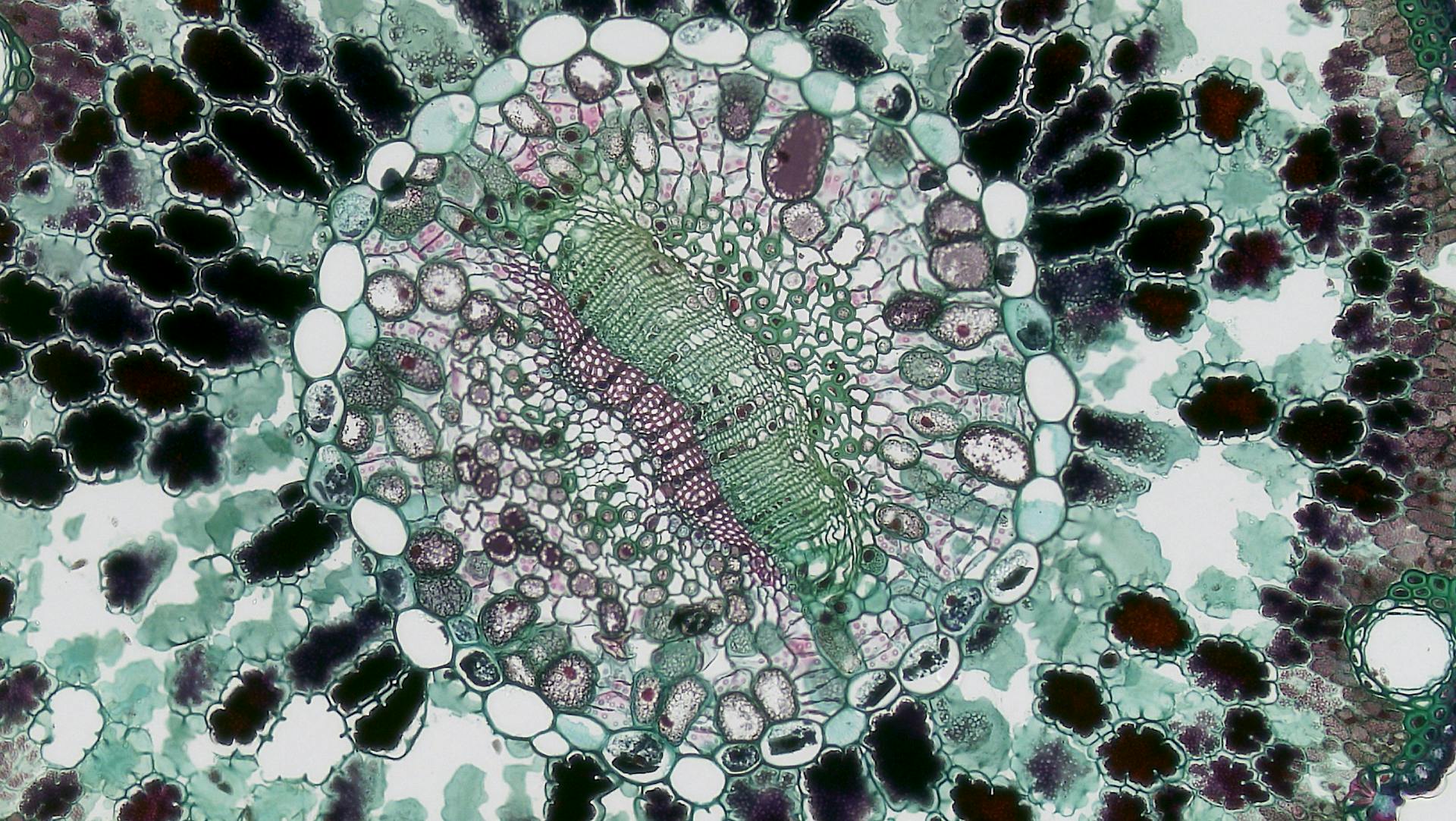
Canine histiocytic diseases are a group of rare conditions that affect dogs, causing their immune system to malfunction.
These diseases are characterized by the abnormal growth of histiocytes, a type of immune cell, in various organs and tissues.
Histiocytic diseases in dogs can manifest in different ways, including skin lesions, joint pain, and organ dysfunction.
One common type of canine histiocytic disease is Cutaneous Histiocytoma, which is a benign skin tumor that typically affects young dogs.
What Are Canine Histiocytic Diseases?
Canine histiocytic diseases are a group of conditions that affect the body's immune system, specifically the histiocytes, which are a type of immune cell.
These diseases can be caused by a genetic mutation that leads to an overproduction of histiocytes, which can then accumulate in various parts of the body.
The most common canine histiocytic disease is Langerhans cell histiocytosis (LCH), which affects the skin, bones, and other organs.
LCH can cause a range of symptoms, including skin lesions, joint pain, and difficulty breathing.
The disease is often diagnosed through a combination of physical examination, laboratory tests, and imaging studies.
Treatment for LCH typically involves a combination of chemotherapy, radiation therapy, and surgery to remove affected tissues.
In some cases, LCH can be a self-limiting condition, meaning it may resolve on its own without treatment.
For another approach, see: Canine Cancer Treatment
Causes and Symptoms
Malignant histiocytosis in dogs can be a complex and challenging disease to diagnose. The definitive cause of this disease is still unknown, but some breeds seem to be more prone to it.
Some breeds that are more likely to develop malignant histiocytosis include Bernese Mountain Dogs, Boxers, Briards, Bull Terriers, Chinese Shar Peis, Cocker Spaniels, Collies, Dachshunds, Flat Coated Retrievers, German Shepherds, Golden Retrievers, Great Danes, Rottweilers, and Shetland Sheepdogs.
The symptoms of malignant histiocytosis can vary widely depending on which organs are affected by tumor growth. Some common symptoms include loss of appetite, weight loss, vomiting, fever, lethargy, depression, coughing, difficulty breathing, diarrhea, limping, lameness, incoordination, neurological disturbances, paralysis, seizures, anemia, and jaundice.
For your interest: Dog Vision Loss Symptoms
Symptoms in Dogs

Symptoms in Dogs can be quite varied and depend on which organs are affected by the tumor growth. If your dog is experiencing difficulty breathing, it may be a sign that the lungs are involved.
Loss of appetite and weight loss are common symptoms, and it's essential to note that these can be signs of other health issues as well. If your dog is vomiting, it may be a sign that the digestive system is affected.
Fever, lethargy, and depression are all possible symptoms, and it's crucial to monitor your dog's behavior closely. Coughing and difficulty breathing can be signs that the respiratory system is involved.
A dog with diarrhea may be experiencing gastrointestinal issues, while limping or lameness can indicate problems with the skeletal system. Incoordination and neurological disturbances are also possible symptoms.
Some dogs may experience paralysis, seizures, anemia, or jaundice, which can be life-threatening if left untreated. It's essential to work closely with your veterinarian to determine the best course of action.
Here are some common symptoms of Malignant Histiocytosis in Dogs:
- Loss of appetite
- Weight loss
- Vomiting
- Fever
- Lethargy
- Depression
- Coughing
- Difficulty breathing
- Diarrhea
- Limping
- Lameness
- Incoordination
- Neurological disturbances
- Paralysis
- Seizures
- Anemia
- Jaundice
Causes in Dogs
Malignant histiocytosis in dogs is a complex condition, and unfortunately, the exact cause is still unknown.
Some researchers believe that these tumors are a type of soft tissue sarcoma, while others categorize them as a histiocytic sarcoma, possibly influenced by an abnormal amount of histiocytes, a type of white blood cell that plays a crucial role in the immune system.
Certain breeds seem to be more prone to developing malignant histiocytosis, including:
- Bernese Mountain Dogs
- Boxers
- Briards
- Bull Terriers
- Chinese Shar Peis
- Cocker Spaniels
- Collies
- Dachshunds
- Flat Coated Retrievers
- German Shepherds
- Golden Retrievers
- Great Danes
- Rottweilers
- Shetland Sheepdogs
Reactive
Reactive histiocytosis is a condition that affects dogs, with two forms: cutaneous and systemic.
Cutaneous histiocytosis is a skin condition that affects middle-aged to older dogs, with no reported breed or sex predilection.
The clinical presentation is typically multiple cutaneous nodules, crusts, or areas of depigmentation on the face, ears, nose, neck, trunk, extremities, perineum, and scrotum.
These lesions can appear to wax and wane, and they're most commonly found on the nasal planum and scrotum.
Systemic histiocytosis is a more severe form of the condition, involving not just the skin but also the ocular and nasal mucosa, and peripheral lymph nodes.
See what others are reading: Kennel Cough Nasal Discharge

Lesions can also develop in the lungs, spleen, liver, or bone marrow, leading to symptoms like weight loss, anorexia, conjunctivitis, and stertor.
A breed predilection for systemic histiocytosis has been documented in rottweilers and golden and Labrador retrievers.
Systemic histiocytosis was first reported in young to middle-aged male Bernese mountain dogs, and it's believed to have a polygenic mode of inheritance.
Diagnosis
Diagnosis is a crucial step in treating canine histiocytic diseases. Your veterinarian will likely perform a physical exam to look for signs of tumors on your dog's skin.
Visible tumors or symptoms can help your veterinarian identify the affected organs. Be sure to share all symptoms you've observed with your vet, as they can be key to pinpointing the issue.
Blood samples may be taken and analyzed to check for anemia or increased liver enzymes. A urinalysis can also be performed to look for abnormalities.
X-rays, CT scans, ultrasounds, and MRIs can help assess if the tumors have spread to internal organs and tissues. These tests can also alert your veterinarian to potential complications, such as an enlarged liver or spleen, or fluid in lung cavities.
You might like: Skin Relief for Dogs with Allergies
Immunohistochemistry can help differentiate between benign and malignant tumors, as well as determine the type of cancer your dog may have. It can also help identify the origin of the tumors.
Here's a breakdown of some common immunohistological markers for canine histiocytic diseases:
A biopsy or tissue sample of the tumors, or any excessive fluids that have collected in body cavities, may be taken and analyzed to confirm the diagnosis.
Types of Canine Histiocytic Diseases
Histiocytoma is a common, benign, cutaneous neoplasm in dogs. It usually occurs as a solitary lesion that spontaneously regresses and seldom recurs.
Dogs of all ages can be affected, but histiocytomas are more likely in dogs under three years of age. Epidermal invasion by cells of histiocytoma can occur and may resemble Pautrier's aggregates found in epidermotropic lymphoma.
Multiple histiocytomas can be mistaken for cutaneous histiocytosis, but they have distinct characteristics. Delayed regression of multiple histiocytomas can occur, and lesions can persist for up to 10 months.
Intriguing read: Images of Histiocytoma in Dogs
Histiocytic sarcomas have more varied origins and can arise from cells in different parts of the body. Splenic histiocytic sarcomas often arise from cells sharing the phenotype of interdigitating dendritic cells of the white pulp.
Hemophagocytic histiocytic sarcoma is a distinct subtype characterized by hemophagocytosis and Coombs' negative regenerative anemia. It shares many characteristics with other histiocytic sarcomas but has a unique origin from splenic red pulp and bone marrow macrophages.
Cutaneous Histiocytoma
Cutaneous Histiocytoma is a common, benign, cutaneous neoplasm in dogs. It usually occurs as a solitary lesion that spontaneously regresses and seldom recurs.
Histiocytomas can occur in dogs of all ages, but are more likely in dogs under three years of age. Epidermal invasion by cells of histiocytoma frequently occurs and intra-epidermal nests of histiocytes resemble Pautrier's aggregates, characteristically found in epidermotropic lymphoma.
Histiocytomas are benign skin tumors that occur most commonly in young dogs, accounting for 3% to 14% of skin tumors in this species. They can look like cutaneous histiocytosis, but morphologically histiocytomas are consistently epidermotropic and commonly epidermally invasive.
Multiple histiocytomas may be a syndrome, and in some cases, the lesions can be almost confluent in affected regions. Rapid internal spread is observed, and unfortunately, the affected animals have all been euthanized.
Histiocytes in cutaneous histiocytoma express markers characteristic of epidermal Langerhans cells such as CD1a, CD11c, MHC class II, and E-cadherin, but not Thy-1 or CD4. This disease is a localized, regressing Langerhans cell histiocytosis.
Histiocytic Sarcoma
Histiocytic sarcomas are a type of canine histiocytic disease that can arise from different cell lineages. They are a common type of histiocytic sarcoma.
Histiocytic sarcomas can arise from cells in various organs, including the spleen, bone marrow, and lungs. They can also arise from subsynovial perivascular dendritic cells.
In some cases, histiocytic sarcomas can be aggressive and spread to multiple organs, causing a range of symptoms including lethargy, inappetence, weight loss, and pale mucous membranes. These symptoms can be similar to those seen in other types of canine histiocytic diseases.
Hemophagocytic histiocytic sarcoma is a distinct subtype of histiocytic sarcoma that is characterized by hemophagocytosis and Coombs' negative regenerative anemia. This type of sarcoma is more common in certain breeds, including Bernese mountain dogs, retrievers, and rottweilers.
Hemophagocytic histiocytic sarcoma is typically diagnosed through immunohistochemical analysis, which can confirm the presence of splenic macrophage origin and rule out dendritic cell origin. This type of sarcoma is known to have a rapid disease progression, with a reported mean survival time from diagnosis until death of seven weeks.
Treatment for hemophagocytic histiocytic sarcoma is not well established, but it is recommended to use chemotherapeutic agents that have known efficacy against localized and disseminated histiocytic sarcoma.
Treatment and Prognosis
In most cases, histiocytomas spontaneously regress within three months.
Surgical excision is often curative and should be used in patients with nodules that are ulcerated, infected, or pruritic.
The prognosis for solitary regressing cutaneous histiocytoma is excellent.
For dogs with multiple nodules, the regression may be more prolonged, but ultimately regression occurs and a good prognosis can be given.
Untreated, the clinical course of disseminated histiocytic sarcoma is rapid and fatal.
Response rates to treatment are poor and survival times are short, typically between 3-4 months.
A subset of dogs with localized histiocytic sarcoma treated with aggressive surgery and chemotherapy can enjoy long-term survival, on average between 1.5 to ~ 3 years.
The prognosis for hemophagocytic histiocytic sarcoma is considered grave, with less than 2 months to live.
Additional reading: Canine Cancer Prognosis
Recovery and Clinical Findings
Recovery from canine histiocytic diseases is often poor, especially if tumors have spread into internal organs. If caught early, treatments can give dogs many more months or years of life.
Tumors can quickly spread into internal organs, making prompt diagnosis and treatment crucial. This emphasizes the importance of monitoring your dog's skin for any lumps, masses, or abnormal growths.
Getting these growths checked by a veterinarian can result in quick and life-saving treatment before the condition progresses too far.
A fresh viewpoint: Dog Lick Granuloma Treatment
Recovery of Dogs
The prognosis for recovery from malignant histiocytosis in dogs is poor.

Tumors are rapidly progressive, and can quickly spread into internal organs.
If tumors have not spread into internal organs, treatments can give many more months or years of life to your dog.
You can help a quick diagnosis by monitoring any lumps, masses, or abnormal growths that may appear on your dog’s skin.
Take a look at this: Canine Brain Tumors
Signalment and Clinical Findings
Histiocytomas can occur in dogs of any age, but the incidence drops after 3 years of age.
A breed predilection has been documented in certain breeds, including boxers, dachshunds, cocker spaniels, Great Danes, Shetland sheepdogs, and bull terriers.
Histiocytomas are usually small, fast-growing, raised, button-like, hairless lesions, typically less than 2-3 cm in size.
These tumors are most commonly found on the extremities, head, ears, or neck, and can be solitary or multiple.
Recommended read: Pedigree Dog Age Converter
Clinical Staging
Clinical staging is a crucial aspect of recovery, and it involves evaluating the severity of the condition. This process helps healthcare professionals determine the best course of treatment.
The clinical staging system assesses the extent of tissue damage and inflammation, which can be mild, moderate, or severe. In cases where the condition is severe, surgical intervention may be necessary.

During the clinical staging process, healthcare professionals also evaluate the patient's symptoms and medical history. This information helps them develop an effective treatment plan that addresses the underlying causes of the condition.
The clinical staging system can be applied to various conditions, including those affecting the skin, muscles, and joints. For example, in cases of skin conditions, the clinical staging system assesses the severity of symptoms such as redness, swelling, and scarring.
In some cases, the clinical staging system may involve imaging tests, such as X-rays or MRIs, to evaluate the extent of tissue damage. This information helps healthcare professionals develop a comprehensive treatment plan that addresses the underlying causes of the condition.
Additional reading: Canine Leishmaniasis Treatment
Frequently Asked Questions
What is the difference between histiocytoma and histiocytosis in dogs?
Histiocytoma typically appears as a single lesion in young dogs and often resolves on its own, whereas histiocytosis involves multiple lesions and requires further investigation. The key difference lies in the number and characteristics of the lesions, with histiocytosis often indicating a more complex condition.
Sources
- https://en.wikipedia.org/wiki/Canine_histiocytic_diseases
- https://wagwalking.com/condition/malignant-histiocytosis
- https://www.histiocytosis.ucdavis.edu/histiocytosis/overview-histiocytic-diseases-dvm-version
- https://www.dvm360.com/view/overview-canine-histiocytic-disorders
- https://hospital.cvm.ncsu.edu/services/small-animals/cancer-oncology/oncology/canine-histiocytic-sarcoma/
Featured Images: pexels.com


